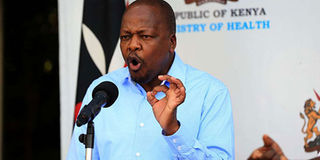Looming PR disaster in Covid-19 war

Health Cabinet Secretary Mutahi Kagwe updating the country on the Covid-19 situation, at Afya House in Nairobi on April 4, 2020. PHOTO | SILA KIPLAGAT | NATION MEDIA GROUP
What you need to know:
- The emerging communication problems for President Uhuru Kenyatta’s administration are mostly self-inflicted.
- Media leaks from persons in forced quarantine or isolation facilities have exposed a government not only badly unprepared but also negligent.
John M. Barry, the American historian and author of The Great Influenza, in an interview on CGTN last week, pointed out several similarities between the 1918 pandemic and the current one, Covid-19.
What stood out for me from the interview were Barry’s observations about the challenges the authorities have had trying to communicate with the public on both pandemics.
The 1918 outbreak struck amid World War I. Most governments, concerned more about winning or losing the military war, tended to play down the seriousness of the pandemic.
Wartime US President Woodrow Wilson, for instance, mostly hid the truth about the outbreak from the public.
The decision to withhold information, Barry said, gravely undermined the Wilson administration’s efforts to contain the disease.
Individuals and communities, for example, tended to ignore public health measures such as social distancing.
Covid-19 might not have come in the thick of a world war. But the pandemic has presented the authorities with as much communication headache as its 1918 forebear, if not worse.
MEDIA LEAKS
The pain of collapsing economies inflicted by the virus across the world has stoked fears of widespread social unrest and even some governments falling.
In the US, President Donald Trump’s overly positive media briefings on the pandemic are widely seen as being informed by personal anxieties about opinion poll ratings ahead of a re-election campaign later in the year.
Mr Trump’s supporters are reportedly angry with Dr Anthony Fauci, the infectious-disease expert who often gives unflattering assessments of the virus that has appeared to overwhelm the world’s military superpower.
Here in Kenya, the State’s communication machine started roaring fairly well, with Health Cabinet Secretary Mutahi Kagwe particularly winning the hearts and minds of many people with his performance at regular media briefings.
But the strain is beginning to show, with reports of more people testing positive and some dying.
The looming PR disaster for the Kenyan authorities has less to do with any fears of an apocalypse. By Saturday, the country had recorded only 126 confirmed cases.
The emerging communication problems for President Uhuru Kenyatta’s administration are mostly self-inflicted.
Media leaks from persons in forced quarantine or isolation facilities have exposed a government not only badly unprepared but also negligent.
CURFEW
Some people taken in there over 10 days ago say they have yet to be tested.
The conditions in some of those facilities haven’t made it possible for the detainees to observe social distancing rules – they share washrooms and use the same doors to their rooms, for example.
A Nairobi MP who spoke up for some of these people was last week summoned by police for questioning.
Within the first week of the night curfew, police have killed at least three people (against four killed by the virus) and maimed many others, fuelling distrust of the government and its messages among the population.
[email protected]; @otienootieno





